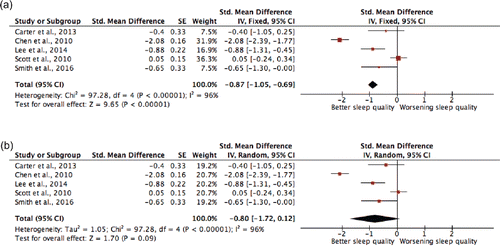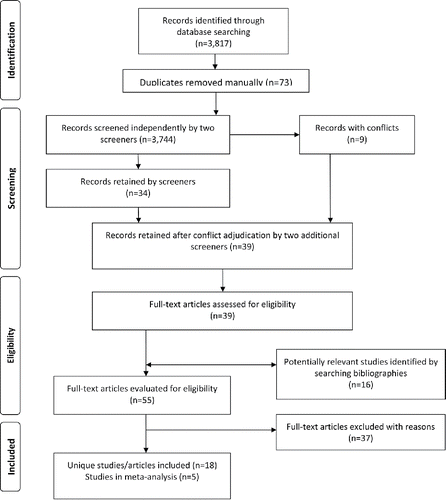Figures & data
Table 1. Description of the sleep health and/or fatigue-related education/training intervention/program
Table 2. Synthesis of findings on the impact of fatigue/sleep education and/or training programs on critical and important outcomes
Figure 2. a) Forest Plot (outcome: sleep quality 4–8 weeks post-intervention follow-up fixed effects model. b) Forest Plot (outcome: sleep quality 4–8 weeks post-intervention follow-up random effects model) The figure reports the standardized mean difference (SMD) for sleep quality as measured by the within-group change in the Pittsburgh Sleep Quality Index (PSQI) during the post-intervention follow-up in five studies occurring between 4 and 8 weeks relative to baseline. The SMDs for these studies are the estimated change from baseline relative to the variability in the study and also known as Cohen's d measurement of effect size. The effect size is not tied to a specific scale or scales used in the pooled analysis. An SMD of zero implies there was no change from baseline. An SMD less than zero indicates the outcome at follow up was less than at baseline. Common delineations or cut-points for interpretation include: 0.2 = small; 0.5 = medium/moderate; 0.8 or greater as large. The SMD is non-significant if the corresponding 95% confidence interval is wide and overlaps 0. For the Carter et al. study we used the PSQI measurements at baseline and 5 weeks follow-up Citation(40). For the Chen et al. study, we used the PSQI measurements at baseline and 5 weeks follow-up Citation(11). For the Scott et al. study, we used the PSQI measurements at baseline and 4 weeks follow-up Citation(32). For the Smith et al. study, we used the PSQI measurements at baseline and 8 weeks follow-up Citation(35). For the Lee et al. study, we used the PSQI measurements at baseline (T1) and (T3) 4 weeks after intervention phase follow-up Citation(39). The standard deviations were estimated using the standard deviations from the baseline and follow up measure assuming a positive, moderate correlation between measurements within the same individual: SD for the change = √(SD2 baseline + SD2 follow-up −2*0.5*SDbaseline*SDfollow up).


